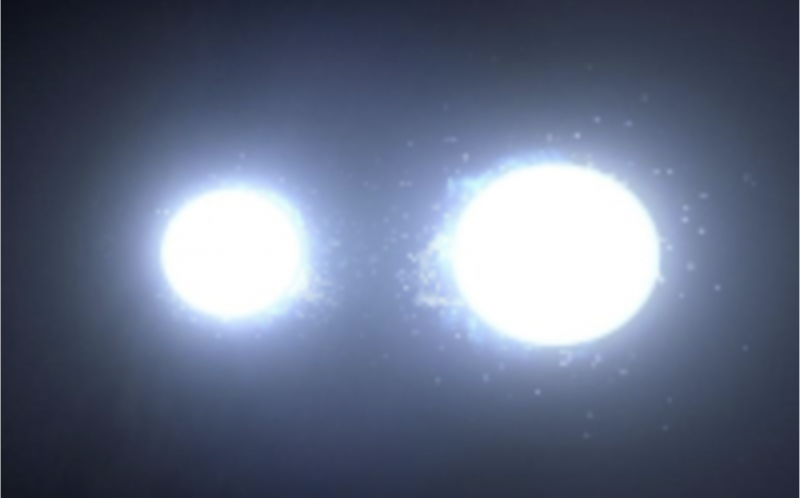
Spica is a close double star
The star Spica – aka Alpha Virginis – is the brightest star in the constellation Virgo the Maiden. From a distance of 262 light-years away, Spica appears to us on Earth to be a lone bluish-white star in a quiet region of the sky. But Spica consists of two stars and maybe more. The pair are both larger and hotter than our sun, and they’re separated by only 11 million miles (less than 18 million km). They orbit their common center of gravity in only four days.
Earth is 93.3 million miles (150 million km, or 1 astronomical unit aka AU) from our sun. Spica’s two stars are only .12 AU from each other, a small fraction of the Earth-sun distance.
And so the two stars in the Spica system are individually indistinguishable from a single point of light, even with a telescope. The dual nature of this star was revealed only by analysis of its light with a spectroscope, an instrument that splits light into its component colors.
Hot, hot, hot
Spica’s two stars are so close, and they orbit so quickly around each other, that their mutual gravity distorts each star into an egg shape. It’s thought that the pointed ends of these egg-shaped stars face each other as they whirl around.
The pair of stars are both dwarfs, brightening near the end of their lifetimes.
Spica is considered one of the hottest 1st-magnitude stars. The hottest of the pair is 22,400 Kelvin (about 40,000 F or 22,000 C). That’s blistering in contrast to the sun’s 5,800 Kelvin (about 10,000 F or 5,500 C). This star might someday explode as a supernova.
The light from Spica’s two stars, taken together, is on average more than 2,200 times brighter than our sun’s light. Their diameters are estimated to be 7.8 and 4 times our sun’s diameter.
Spica is one of several bright stars that the moon can occult (eclipse). Based on observations of how the star’s light is extinguished when the moon passes in front, some astronomers think that it may not just be a spectroscopic binary star. Instead, they feel that there may be as many as three other stars in the system. This would make Spica not a single or even a double, but a quintuple star!
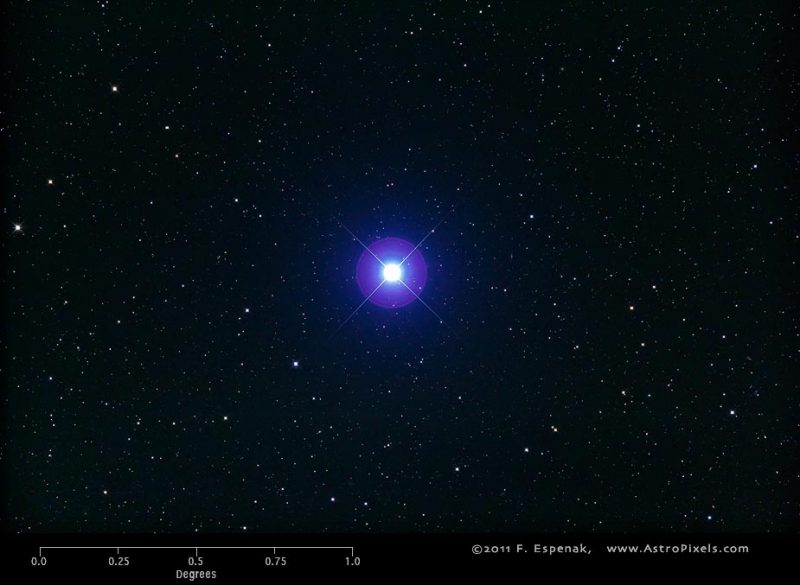

How to find Spica
The best evening views of Spica come from northern spring to late northern summer, when this star arcs across the southern sky in the evening. In the month of May, as seen from the Northern Hemisphere, you’ll find Spica in the southeast in early evening. From the Southern Hemisphere, Spica is closer to due east. From all of Earth in May, as night passes, Spica appears to move westward. Spica rises earlier each evening so that – by the end of August – Spica can be viewed only briefly in the west to west-southwest sky as darkness falls.
There’s a fool-proof way to find Spica, using the Big Dipper as a guide. Scouts and stargazers remember this trick with the saying: Follow the arc to Arcturus, and speed on (or drive a spike) to Spica.
Look for the Dipper in the northern sky. It’s highest in the evening sky in northern spring and summer. Notice that the Big Dipper has a bowl and a long, curved handle. Follow the arc of the Dipper’s handle outward, away from the Dipper’s bowl. The first bright star you come to is orange Arcturus. Then drive a spike (or speed on) along this curving path. The next bright star you come to is Spica.
Spica shines at magnitude 1.04, making it the brightest light in Virgo. It’s the 15th-brightest star visible from anywhere on Earth. It’s virtually the same brightness as Antares in the constellation Scorpius, so sometimes Antares is listed as the 15th and Spica as the 16th brightest. No matter.
Identify this beautiful blue-white star with the Big Dipper’s help to spot it in the sky. If you do, this star will be your friend for life.
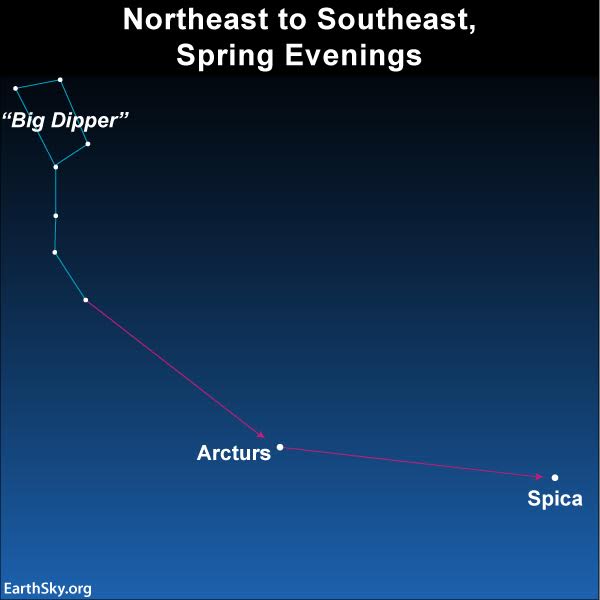
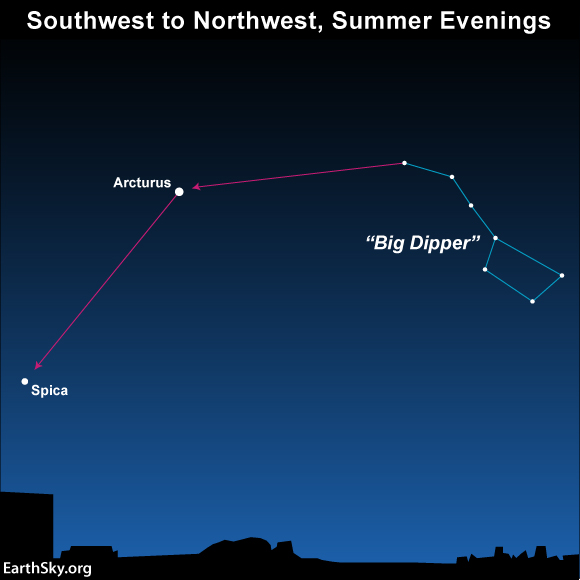
History and mythology of Spica
The name Spica is from the Latin word for “ear” (of grain). The general connotation is that Spica refers to an “ear of wheat.” Indeed, the star and the constellation Virgo itself were sometimes associated with the Greek goddess of the harvest, Demeter.
There are many names and stories for Spica’s constellation – Virgo – in mythology, and by association with Spica as well. Fewer stories refer to Spica independently. Many classical references refer to Virgo’s stars as a goddess or with some association with wheat or the harvest, due to the fact that the sun passes through Virgo in the fall. In Greece and Rome she typically was Astraea, the very personification of Justice; or Persephone, daughter of Demeter. In Egypt, Virgo was identified with Isis, and Spica was considered her lute bearer. In ancient China, Spica was a special star of spring known as the Horn.
One Arabic name was Azimech, derived from words meaning Defenseless One or Solitary One. This title may be in reference to Spica’s solitary status with no other bright stars nearby. But Spica is not the most solitary star. That honor goes to Fomalhaut, sometimes called the Autumn Star.
Spica’s position is RA: 13h 25m 12s, dec: -11° 09′ 41″
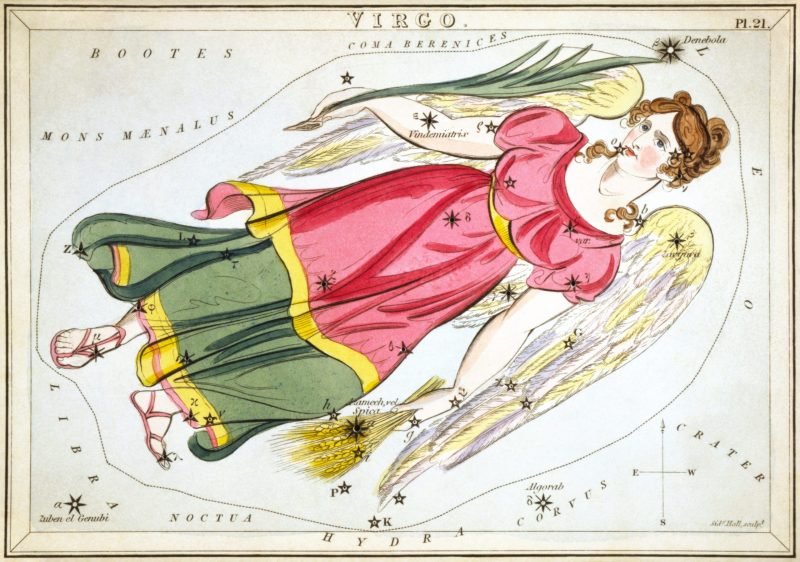
Bottom line: Spica is the brightest star in Virgo. Spica is at least two stars orbiting extremely close together, distorting each other into egg shapes.
Virgo? Here’s your constellation
The post Spica, bright beacon of Virgo, is 2 stars first appeared on EarthSky.
from EarthSky https://ift.tt/3igkP8s

Spica is a close double star
The star Spica – aka Alpha Virginis – is the brightest star in the constellation Virgo the Maiden. From a distance of 262 light-years away, Spica appears to us on Earth to be a lone bluish-white star in a quiet region of the sky. But Spica consists of two stars and maybe more. The pair are both larger and hotter than our sun, and they’re separated by only 11 million miles (less than 18 million km). They orbit their common center of gravity in only four days.
Earth is 93.3 million miles (150 million km, or 1 astronomical unit aka AU) from our sun. Spica’s two stars are only .12 AU from each other, a small fraction of the Earth-sun distance.
And so the two stars in the Spica system are individually indistinguishable from a single point of light, even with a telescope. The dual nature of this star was revealed only by analysis of its light with a spectroscope, an instrument that splits light into its component colors.
Hot, hot, hot
Spica’s two stars are so close, and they orbit so quickly around each other, that their mutual gravity distorts each star into an egg shape. It’s thought that the pointed ends of these egg-shaped stars face each other as they whirl around.
The pair of stars are both dwarfs, brightening near the end of their lifetimes.
Spica is considered one of the hottest 1st-magnitude stars. The hottest of the pair is 22,400 Kelvin (about 40,000 F or 22,000 C). That’s blistering in contrast to the sun’s 5,800 Kelvin (about 10,000 F or 5,500 C). This star might someday explode as a supernova.
The light from Spica’s two stars, taken together, is on average more than 2,200 times brighter than our sun’s light. Their diameters are estimated to be 7.8 and 4 times our sun’s diameter.
Spica is one of several bright stars that the moon can occult (eclipse). Based on observations of how the star’s light is extinguished when the moon passes in front, some astronomers think that it may not just be a spectroscopic binary star. Instead, they feel that there may be as many as three other stars in the system. This would make Spica not a single or even a double, but a quintuple star!


How to find Spica
The best evening views of Spica come from northern spring to late northern summer, when this star arcs across the southern sky in the evening. In the month of May, as seen from the Northern Hemisphere, you’ll find Spica in the southeast in early evening. From the Southern Hemisphere, Spica is closer to due east. From all of Earth in May, as night passes, Spica appears to move westward. Spica rises earlier each evening so that – by the end of August – Spica can be viewed only briefly in the west to west-southwest sky as darkness falls.
There’s a fool-proof way to find Spica, using the Big Dipper as a guide. Scouts and stargazers remember this trick with the saying: Follow the arc to Arcturus, and speed on (or drive a spike) to Spica.
Look for the Dipper in the northern sky. It’s highest in the evening sky in northern spring and summer. Notice that the Big Dipper has a bowl and a long, curved handle. Follow the arc of the Dipper’s handle outward, away from the Dipper’s bowl. The first bright star you come to is orange Arcturus. Then drive a spike (or speed on) along this curving path. The next bright star you come to is Spica.
Spica shines at magnitude 1.04, making it the brightest light in Virgo. It’s the 15th-brightest star visible from anywhere on Earth. It’s virtually the same brightness as Antares in the constellation Scorpius, so sometimes Antares is listed as the 15th and Spica as the 16th brightest. No matter.
Identify this beautiful blue-white star with the Big Dipper’s help to spot it in the sky. If you do, this star will be your friend for life.


History and mythology of Spica
The name Spica is from the Latin word for “ear” (of grain). The general connotation is that Spica refers to an “ear of wheat.” Indeed, the star and the constellation Virgo itself were sometimes associated with the Greek goddess of the harvest, Demeter.
There are many names and stories for Spica’s constellation – Virgo – in mythology, and by association with Spica as well. Fewer stories refer to Spica independently. Many classical references refer to Virgo’s stars as a goddess or with some association with wheat or the harvest, due to the fact that the sun passes through Virgo in the fall. In Greece and Rome she typically was Astraea, the very personification of Justice; or Persephone, daughter of Demeter. In Egypt, Virgo was identified with Isis, and Spica was considered her lute bearer. In ancient China, Spica was a special star of spring known as the Horn.
One Arabic name was Azimech, derived from words meaning Defenseless One or Solitary One. This title may be in reference to Spica’s solitary status with no other bright stars nearby. But Spica is not the most solitary star. That honor goes to Fomalhaut, sometimes called the Autumn Star.
Spica’s position is RA: 13h 25m 12s, dec: -11° 09′ 41″

Bottom line: Spica is the brightest star in Virgo. Spica is at least two stars orbiting extremely close together, distorting each other into egg shapes.
Virgo? Here’s your constellation
The post Spica, bright beacon of Virgo, is 2 stars first appeared on EarthSky.
from EarthSky https://ift.tt/3igkP8s

Aucun commentaire:
Enregistrer un commentaire